The alkylation melamine-formaldehyde resin for coating market stands at the threshold of a decade-long expansion trajectory that promises to reshape chemical industry applications and industrial coating manufacturing across automotive manufacturers, construction contractors, and wood processing operations. The alkylation melamine-formaldehyde resin for coating market's journey from USD 724.0 million in 2025 to USD 1,082.1 million by 2035 represents substantial growth, demonstrating the accelerating adoption of high-performance coating resins and advanced crosslinking solutions across paint manufacturers, industrial coating specialists, and protective coating facilities.
The first half of the decade (2025 to 2030) will witness the alkylation melamine-formaldehyde resin for coating market climbing from USD 724.0 million to approximately USD 876.3 million, adding USD 152.3 million in value, which constitutes 42% of the total forecast growth period. This phase will be characterized by the rapid adoption of advanced alkylation technologies, driven by increasing automotive coating modernization and the growing need for high-performance crosslinking solutions worldwide. Enhanced durability features and chemical resistance capabilities will become standard expectations rather than premium options.
The latter half (2030 to 2035) will witness accelerated growth from USD 876.3 million to USD 1,082.1 million, representing an addition of USD 205.8 million or 58% of the decade's expansion. This period will be defined by mass market penetration of premium alkylation technologies, integration with comprehensive coating formulation platforms, and seamless compatibility with existing industrial coating infrastructure. The alkylation melamine-formaldehyde resin for coating market trajectory signals fundamental shifts in how coating manufacturers approach crosslinking chemistry and performance optimization, with participants positioned to benefit from growing demand across multiple alkylation types and application segments.
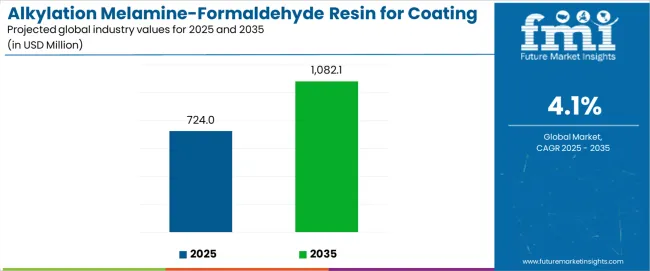
| Period | Primary Revenue Buckets | Share | Notes |
|---|---|---|---|
| Today | Methylation-based resins (automotive, industrial) | 62% | Traditional chemistry, established coatings |
| Butylation systems | 28% | Enhanced flexibility, wood applications | |
| Mixed etherification products | 10% | Specialty applications, high-end coatings | |
| Future (3-5 yrs) | Advanced methylation systems | 55-58% | Enhanced crosslinking, automotive focus |
| High-performance butylation | 22-25% | Flexibility optimization, construction | |
| Automotive coating applications | 15-18% | Premium vehicles, electric car coatings | |
| Wood coating systems | 8-12% | Furniture, architectural applications | |
| Can coating applications | 6-9% | Food packaging, beverage containers | |
| Specialty mixed etherification | 4-7% | High-end applications, marine coatings |
At-a-Glance Metrics
| Metric | Value |
|---|---|
| Market Value (2025) | USD 724.0 million |
| Market Forecast (2035) | USD 1,082.1 million |
| Growth Rate | 4.1% CAGR |
| Leading Classification | Methylation Systems |
| Primary Application | Automotive Coating Segment |
The alkylation melamine-formaldehyde resin for coating market demonstrates strong fundamentals with methylation-based resin systems capturing a dominant share through advanced crosslinking properties and industrial coating optimization. Automotive coating applications drive primary demand, supported by increasing performance requirements and coating industry modernization initiatives. Geographic expansion remains concentrated in developed markets with established chemical manufacturing infrastructure, while emerging economies show accelerating adoption rates driven by industrial coating modernization initiatives and rising performance standards.
Primary Classification: The alkylation melamine-formaldehyde resin for coating market segments by alkylation type into methylation, butylation, mixed etherification, and others, representing the evolution from traditional crosslinking chemistry to sophisticated alkylation techniques for comprehensive coating performance optimization.
Secondary Classification: Application segmentation divides the alkylation melamine-formaldehyde resin for coating market into automotive coating, wood coating, can coating, and others, reflecting distinct requirements for resin performance, durability standards, and chemical resistance specifications.
Tertiary Classification: End-use segmentation covers paint manufacturers, coating specialists, automotive OEMs, furniture manufacturers, and packaging companies, while distribution channels span direct sales, chemical distributors, and specialized coating suppliers.
Quaternary Classification: Performance segmentation includes high-gloss finishes, chemical resistance applications, UV stability systems, and flexibility enhancement, while curing temperature classification spans low-temperature cure, medium-temperature systems, and high-temperature applications.
Regional Classification: Geographic distribution covers North America, Latin America, Western Europe, Eastern Europe, East Asia, South Asia Pacific, and Middle East & Africa, with developed markets leading adoption while emerging economies show accelerating growth patterns driven by industrial coating modernization programs.
The segmentation structure reveals chemistry progression from traditional methylation systems toward sophisticated mixed etherification techniques with enhanced performance capabilities, while application diversity spans from automotive coatings to specialized industrial applications requiring precision crosslinking solutions.
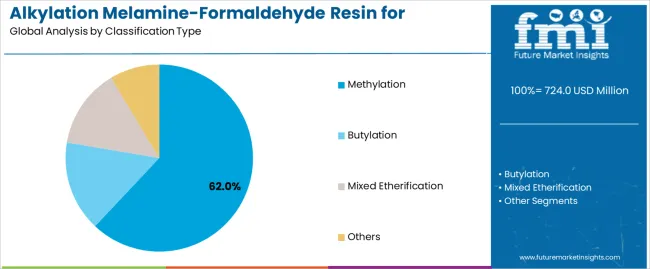
Market Position: Methylation resin systems command the leading position in the alkylation melamine-formaldehyde resin for coating market with 62% market share through proven crosslinking technologies, including enhanced durability construction, chemical resistance properties, and performance optimization that enable coating manufacturers to achieve optimal film formation across diverse automotive and industrial coating environments.
Value Drivers: The segment benefits from coating industry preference for established crosslinking systems that provide reliable performance, chemical resistance, and operational durability without requiring specialized curing infrastructure. Advanced methylation processing features enable enhanced crosslinking density, improved adhesion properties, and integration with existing coating formulations, where performance reliability and chemical resistance represent critical operational requirements.
Competitive Advantages: Methylation resin systems differentiate through proven crosslinking reliability, established chemistry characteristics, and integration with established coating formulation systems that enhance coating effectiveness while maintaining optimal performance standards suitable for diverse industrial applications.
Key market characteristics:
Butylation resin systems maintain a 28% market position in the alkylation melamine-formaldehyde resin for coating market due to their flexibility advantages and enhanced adhesion positioning benefits. These materials appeal to facilities requiring flexible coating solutions with enhanced impact resistance profiles for wood coating operations. Market growth is driven by furniture industry expansion, emphasizing flexibility optimization and durability enhancement through optimized crosslinking designs.
Mixed etherification systems capture 10% market share through specialized performance applications in marine coatings, aerospace applications, and high-end industrial coatings requiring advanced chemical resistance and environmental durability capabilities.
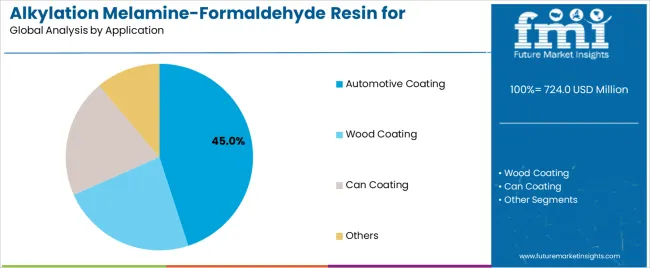
Market Context: Automotive coating applications demonstrate strong growth in the alkylation melamine-formaldehyde resin for coating market with 45% market share due to widespread adoption of high-performance coating systems and increasing focus on automotive excellence, durability optimization, and finish quality applications that maximize coating effectiveness while maintaining premium standards.
Appeal Factors: Automotive manufacturers prioritize coating reliability, finish consistency, and integration with existing automotive infrastructure that enables coordinated coating operations across multiple production lines. The segment benefits from substantial automotive industry investment and modernization programs that emphasize the acquisition of premium resins for finish differentiation and performance enhancement applications.
Growth Drivers: Electric vehicle expansion programs incorporate advanced coating resins as essential components for battery protection and lightweight applications, while luxury automotive growth increases demand for coating capabilities that comply with performance standards and minimize environmental impact.
Market Challenges: Varying automotive requirements and production scale complexity may limit resin standardization across different manufacturers or application scenarios.
Application dynamics include:
Wood coating applications capture 32% market share through specialized protection requirements in furniture manufacturing, architectural coatings, and construction applications. These facilities demand performance resins capable of supporting environmental protection while providing durability enhancement and aesthetic optimization capabilities.
Can coating applications account for 18% market share, including food packaging, beverage containers, and industrial packaging requiring performance coating capabilities for corrosion protection and food safety optimization.
Market Context: Paint Manufacturers dominate the alkylation melamine-formaldehyde resin for coating market with a 5.8% CAGR, reflecting the primary demand source for alkylation melamine-formaldehyde resin technology in coating formulation applications and performance optimization.
Business Model Advantages: Paint Manufacturers provide direct market demand for standardized resin systems, driving volume production and cost optimization while maintaining quality control and performance consistency requirements.
Operational Benefits: Paint Manufacturer applications include formulation standardization, cost efficiency, and quality assurance that drive consistent demand for resin systems while providing access to the latest crosslinking technologies.
| Category | Factor | Impact | Why It Matters |
|---|---|---|---|
| Driver | Automotive industry growth & electric vehicle expansion (ev coatings, battery protection) | ★★★★★ | Growing automotive market requires high-performance coatings with enhanced durability capabilities and chemical resistance properties proven effective across automotive applications. |
| Driver | Performance standards advancement & chemical resistance requirements (corrosion protection, environmental durability) | ★★★★★ | Transforms coating requirements from "basic protection" to "advanced performance"; manufacturers that offer quality resins and resistance features gain competitive advantage. |
| Driver | Industrial coating market growth & advanced applications (aerospace, marine, infrastructure) | ★★★★☆ | Industrial applications need distinctive, high-performance resins; demand for exclusive and superior crosslinking solutions expanding addressable market. |
| Restraint | Raw material cost pressures & supply chain constraints (formaldehyde prices, alkylation agents) | ★★★★☆ | Smaller coating manufacturers defer resin upgrades; increases price sensitivity and slows premium resin adoption in cost-conscious markets. |
| Restraint | Alternative crosslinking options competition (polyurethane systems, acrylic alternatives) | ★★★☆☆ | Alternative crosslinking technologies offer established performance and different cost structures, potentially limiting alkylation adoption in traditional applications. |
| Trend | Chemistry technology integration & performance enhancement (advanced alkylation, curing optimization) | ★★★★★ | Advanced crosslinking properties, durability optimization, and performance analytics transform operations; technology integration and chemistry enhancement become core value propositions. |
| Trend | Customization & application-specific solutions (automotive grades, wood coating formulations) | ★★★★☆ | Custom resins for specific applications and performance requirements; specialized chemistry and targeted application capabilities drive competition toward customization solutions. |
The alkylation melamine-formaldehyde resin for coating market demonstrates varied regional dynamics with Growth Leaders including China (5.5% growth rate) and India (5.1% growth rate) driving expansion through industrial development initiatives and coating industry modernization. Steady Performers encompass Germany (4.7% growth rate), Brazil (4.3% growth rate), and developed regions, benefiting from established chemical industries and advanced coating adoption. Mature Markets feature United States (3.9% growth rate), United Kingdom (3.5% growth rate), and Japan (3.1% growth rate), where automotive advancement and industrial standardization requirements support consistent growth patterns.
Regional synthesis reveals East Asian markets leading adoption through manufacturing expansion and coating technology development, while North American countries maintain steady expansion supported by automotive technology advancement and performance standardization requirements. European markets show strong growth driven by automotive applications and chemistry integration trends.
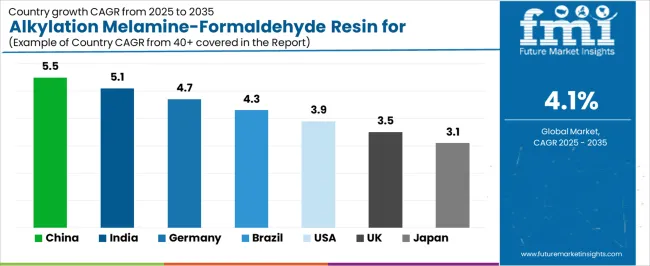
| Region/Country | 2025 to 2035 Growth | How to win | What to watch out |
|---|---|---|---|
| China | 5.5% | Focus on manufacturing scale solutions | Environmental regulations; local competition |
| India | 5.1% | Lead with cost-effective chemistry | Import restrictions; quality barriers |
| Germany | 4.7% | Provide premium automotive resins | Over-regulation; lengthy approvals |
| Brazil | 4.3% | Offer value-oriented formulations | Currency fluctuations; import duties |
| United States | 3.9% | Push technology integration | Compliance costs; scaling challenges |
| United Kingdom | 3.5% | Focus on premium applications | Economic impacts; resin costs |
| Japan | 3.1% | Emphasize quality chemistry | Traditional preferences; adoption rates |
China establishes fastest market growth through aggressive industrial development programs and comprehensive coating industry expansion, integrating advanced alkylation melamine-formaldehyde resin systems as standard components in automotive facilities and industrial coating installations. The country's 5.5% growth rate reflects government initiatives promoting manufacturing infrastructure and domestic resin capabilities that mandate the use of high-performance crosslinking systems in automotive and industrial coating facilities. Growth concentrates in major manufacturing hubs, including Guangdong, Jiangsu, and Shandong, where industrial development showcases integrated resin systems that appeal to coating manufacturers seeking performance optimization capabilities and cost-effective applications.
Chinese manufacturers are developing cost-effective resin solutions that combine domestic production advantages with advanced crosslinking features, including enhanced durability control and improved chemical resistance capabilities. Distribution channels through chemical suppliers and coating distributors expand market access, while government support for manufacturing development supports adoption across diverse automotive and industrial segments.
Strategic Market Indicators:
In Mumbai, Chennai, and Pune, automotive facilities and coating manufacturers are implementing high-performance alkylation melamine-formaldehyde resin systems as standard components for coating formulation and performance optimization applications, driven by increasing government industrial investment and manufacturing modernization programs that emphasize the importance of advanced crosslinking capabilities. The alkylation melamine-formaldehyde resin for coating market holds a 5.1% growth rate, supported by government industrial initiatives and automotive development programs that promote high-performance resin systems for coating and manufacturing facilities. Indian operators are adopting resin systems that provide consistent crosslinking performance and chemical resistance features, particularly appealing in industrial regions where coating performance and durability excellence represent critical business requirements.
Market expansion benefits from growing automotive capabilities and international manufacturing partnerships that enable domestic production of high-performance resin systems for coating and industrial applications. Technology adoption follows patterns established in chemical manufacturing, where reliability and performance drive procurement decisions and operational deployment.
Market Intelligence Brief:
Germany's advanced chemical market demonstrates sophisticated alkylation melamine-formaldehyde resin deployment with documented performance effectiveness in automotive applications and industrial coating facilities through integration with existing chemical systems and manufacturing infrastructure. The country leverages engineering expertise in chemistry and quality systems integration to maintain a 4.7% growth rate. Industrial centers, including North Rhine-Westphalia, Bavaria, and Baden-Württemberg, showcase premium installations where resin systems integrate with comprehensive coating platforms and facility management systems to optimize crosslinking performance and operational effectiveness.
German manufacturers prioritize system quality and EU compliance in resin development, creating demand for premium systems with advanced features, including automotive integration and performance optimization systems. The alkylation melamine-formaldehyde resin for coating market benefits from established chemical infrastructure and a willingness to invest in advanced resin technologies that provide long-term operational benefits and compliance with international coating standards.
Market Intelligence Brief:
Brazil's market expansion benefits from diverse industrial demand, including automotive modernization in São Paulo and Rio Grande do Sul, manufacturing facility upgrades, and government industrial programs that increasingly incorporate high-performance resin solutions for coating applications. The country maintains a 4.3% growth rate, driven by rising manufacturing activity and increasing recognition of advanced resin benefits, including precise crosslinking control and enhanced coating effectiveness.
Market dynamics focus on cost-effective resin solutions that balance crosslinking performance with affordability considerations important to Brazilian coating manufacturers. Growing industrialization creates continued demand for modern resin systems in new manufacturing infrastructure and facility modernization projects.
Strategic Market Considerations:
United States establishes market leadership through comprehensive automotive programs and advanced chemical infrastructure development, integrating alkylation melamine-formaldehyde resin systems across coating and industrial applications. The country's 3.9% growth rate reflects established chemical industry relationships and mature resin technology adoption that supports widespread use of high-performance crosslinking systems in automotive and industrial coating facilities. Growth concentrates in major chemical centers, including Texas, Louisiana, and Ohio, where resin technology showcases mature deployment that appeals to coating manufacturers seeking proven performance capabilities and operational efficiency applications.
American chemical providers leverage established distribution networks and comprehensive technical support capabilities, including formulation programs and training support that create customer relationships and operational advantages. The alkylation melamine-formaldehyde resin for coating market benefits from mature regulatory standards and chemical requirements that mandate resin system use while supporting technology advancement and operational optimization.
Market Intelligence Brief:
United Kingdom's chemical market demonstrates integrated alkylation melamine-formaldehyde resin deployment with documented performance effectiveness in automotive applications and coating facilities through integration with existing chemical systems and manufacturing infrastructure. The country maintains a 3.5% growth rate, supported by automotive excellence programs and performance effectiveness requirements that promote high-performance resin systems for coating applications. Manufacturing facilities across England, Scotland, and Wales showcase systematic installations where resin systems integrate with comprehensive coating platforms to optimize crosslinking performance and operational outcomes.
UK chemical providers prioritize system reliability and industry compatibility in resin procurement, creating demand for validated systems with proven performance features, including quality monitoring integration and crosslinking optimization systems. The alkylation melamine-formaldehyde resin for coating market benefits from established chemical infrastructure and excellence requirements that support resin technology adoption and operational effectiveness.
Market Intelligence Brief:
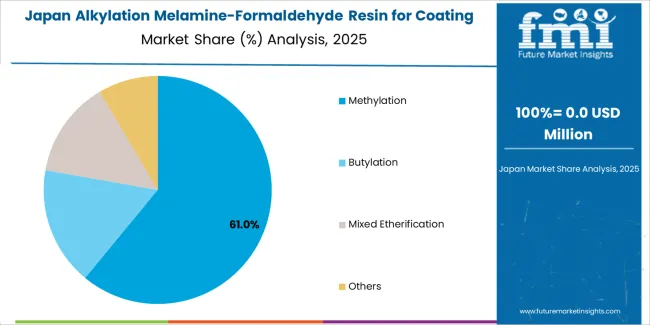
Japan's market growth benefits from precision chemical demand, including advanced automotive facilities in Toyota and Osaka, quality integration, and performance enhancement programs that increasingly incorporate resin solutions for crosslinking applications. The country maintains a 3.1% growth rate, driven by chemical technology advancement and increasing recognition of precision resin benefits, including accurate crosslinking control and enhanced coating outcomes.
Market dynamics focus on high-precision resin solutions that meet Japanese quality standards and performance effectiveness requirements important to chemical operators. Advanced automotive technology adoption creates continued demand for sophisticated resin systems in manufacturing facility infrastructure and coating modernization projects.
Strategic Market Considerations:
The European alkylation melamine-formaldehyde resin for coating market is projected to grow from USD 164.2 million in 2025 to USD 245.8 million by 2035, registering a CAGR of 4.1% over the forecast period. Germany is expected to maintain its leadership position with a 42.1% market share in 2025, supported by its advanced automotive infrastructure and major chemical manufacturing centers.
United Kingdom follows with a 22.4% share in 2025, driven by comprehensive automotive programs and coating excellence development initiatives. France holds a 16.7% share through specialized automotive applications and chemical compliance requirements. Italy commands a 10.8% share, while Spain accounts for 5.2% in 2025. The rest of Europe region is anticipated to gain momentum, expanding its collective share from 2.8% to 3.1% by 2035, attributed to increasing chemical adoption in Nordic countries and emerging coating facilities implementing industrial modernization programs.
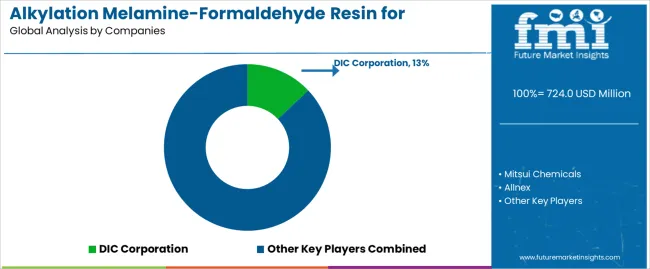
| Stakeholder | What they actually control | Typical strengths | Typical blind spots |
|---|---|---|---|
| Global chemical giants | Production capacity, R&D resources, global distribution | Wide availability, proven chemistry, multi-region support | Product refresh cycles; customer dependency on technical validation |
| Technology innovators | Chemistry R&D; advanced alkylation technologies; enhanced crosslinking properties | Latest technologies first; attractive ROI on performance effectiveness | Service density outside core regions; scaling complexity |
| Regional specialists | Local compliance, fast delivery, nearby technical support | "Close to customer" support; pragmatic pricing; local regulations | Technology gaps; talent retention in technical service |
| Full-service providers | Complete formulation packages, technical services, application support | Lowest operational risk; comprehensive support | Service costs if overpromised; technology obsolescence |
| Niche specialists | Specialized applications, custom chemistry, performance grades | Win premium applications; flexible configurations | Scalability limitations; narrow market focus |
| Item | Value |
|---|---|
| Quantitative Units | USD 724.0 million |
| Classification Type | Methylation, Butylation, Mixed Etherification, Others |
| Application | Automotive Coating, Wood Coating, Can Coating, Others |
| End Use | Paint Manufacturers, Coating Specialists, Automotive OEMs, Furniture Manufacturers, Packaging Companies |
| Regions Covered | North America, Latin America, Western Europe, Eastern Europe, East Asia, South Asia Pacific, Middle East & Africa |
| Countries Covered | China, India, Germany, Brazil, United States, United Kingdom, Japan, Canada, France, Australia, and 25+ additional countries |
| Key Companies Profiled | DIC Corporation, Mitsui Chemicals, Allnex, Prefere Resins Holding, BASF, Hexion, Eternal Materials Co., Ltd, CHUEN HUAH CHEMICAL, Chongqing ChangFeng Chemical Co., Ltd |
| Additional Attributes | Dollar sales by classification type and application categories, regional adoption trends across East Asia, North America, and Western Europe, competitive landscape with chemical manufacturers and resin suppliers, coating manufacturer preferences for crosslinking effectiveness and performance optimization, integration with coating formulation platforms and quality management systems, innovations in alkylation chemistry and resin enhancement, and development of advanced crosslinking solutions with enhanced performance and operational optimization capabilities. |
The global alkylation melamine-formaldehyde resin for coating market is estimated to be valued at USD 724.0 million in 2025.
The market size for the alkylation melamine-formaldehyde resin for coating market is projected to reach USD 1,082.1 million by 2035.
The alkylation melamine-formaldehyde resin for coating market is expected to grow at a 4.1% CAGR between 2025 and 2035.
The key product types in alkylation melamine-formaldehyde resin for coating market are methylation, butylation, mixed etherification and others.
In terms of application, automotive coating segment to command 45.0% share in the alkylation melamine-formaldehyde resin for coating market in 2025.






Full Research Suite comprises of:
Market outlook & trends analysis
Interviews & case studies
Strategic recommendations
Vendor profiles & capabilities analysis
5-year forecasts
8 regions and 60+ country-level data splits
Market segment data splits
12 months of continuous data updates
DELIVERED AS:
PDF EXCEL ONLINE
Coating Pretreatment Market Size and Share Forecast Outlook 2025 to 2035
Coating Auxiliaries Market Size and Share Forecast Outlook 2025 to 2035
Coating Additives Market Growth – Trends & Forecast 2025 to 2035
Coating Thickness Gauge Market
Coating Thickness Measurement Instruments Market
AR Coating Liquid Market Size and Share Forecast Outlook 2025 to 2035
UV Coatings Market Growth & Forecast 2025 to 2035
2K Coatings Market Growth – Trends & Forecast 2025 to 2035
Coil Coatings Market Size and Share Forecast Outlook 2025 to 2035
Nano Coating Market Size and Share Forecast Outlook 2025 to 2035
Pipe Coatings Market Size and Share Forecast Outlook 2025 to 2035
Food Coating Ingredients Market Analysis – Size, Share, and Forecast Outlook 2025 to 2035
Seed Coating Material Market Analysis - Size, Share, and Forecast 2025 to 2035
Wood Coatings Market Size, Growth, and Forecast for 2025 to 2035
Paper Coating Binders Market Size and Share Forecast Outlook 2025 to 2035
Paper Coating Materials Market Size and Share Forecast Outlook 2025 to 2035
Smart Coatings Market Size and Share Forecast Outlook 2025 to 2035
Green Coatings Market Analysis by Technology, Application, and Region Forecast through 2035
Rubber Coating Market Size and Share Forecast Outlook 2025 to 2035
Marine Coatings Market Size and Share Forecast Outlook 2025 to 2035

Thank you!
You will receive an email from our Business Development Manager. Please be sure to check your SPAM/JUNK folder too.
Chat With
MaRIA